
 Pope Benedict blesses
Pope Benedict blesses
restored Pauline Chapel

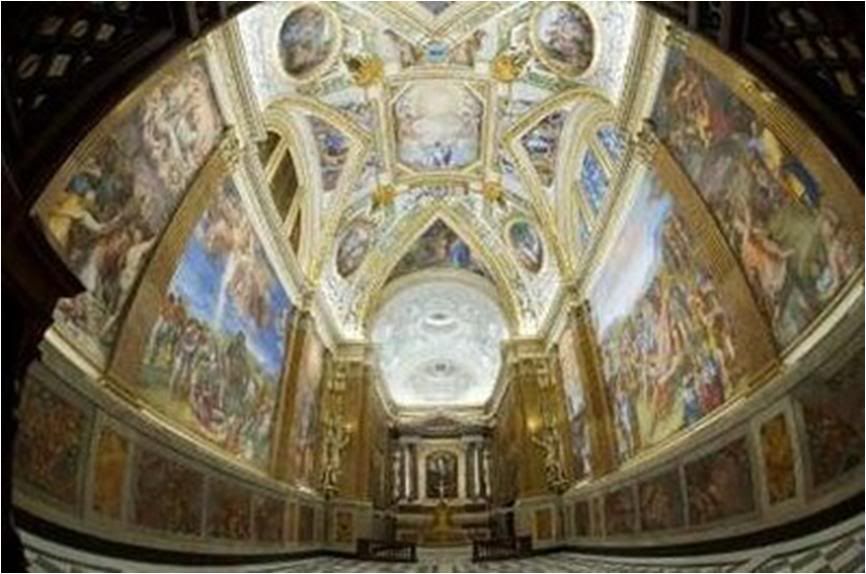

VATICAN CITY, July 4 (Translated from Apcom) - The Pauline Chapel in the Apostolic Palace has returned to its full splendor, and it was blessed today by Pope Benedict XVI.
After 7 years of restoration, the chapel - considered to be a personal chapel for the Pope and the Pontifical Household - formally reopened with afternoon Vespers led by Benedict XVI.
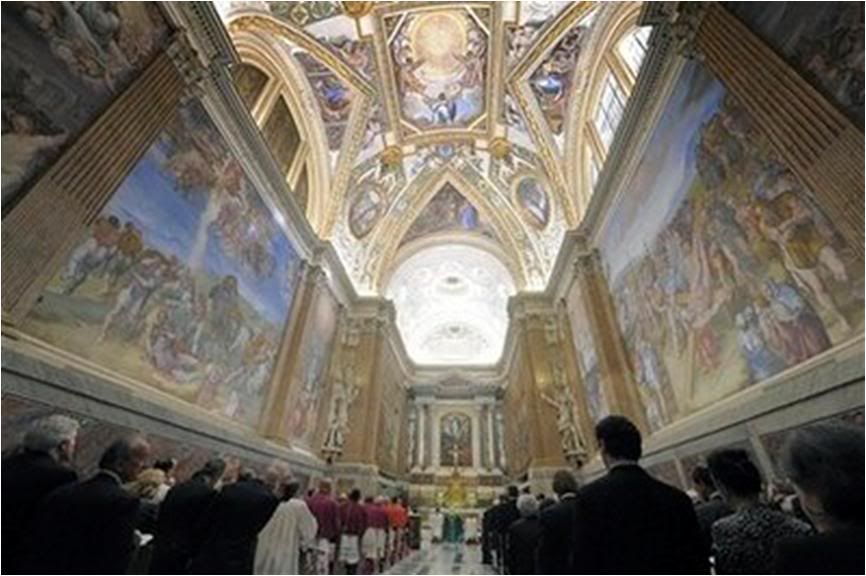
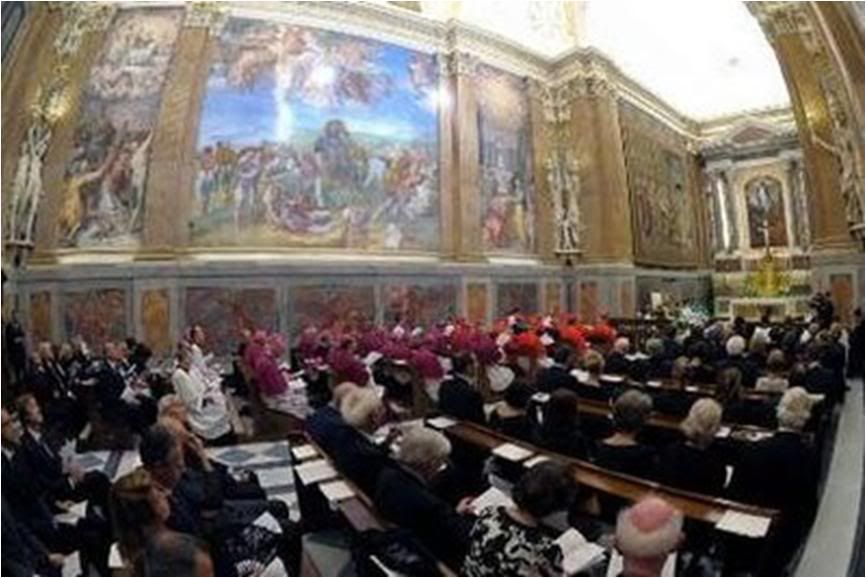
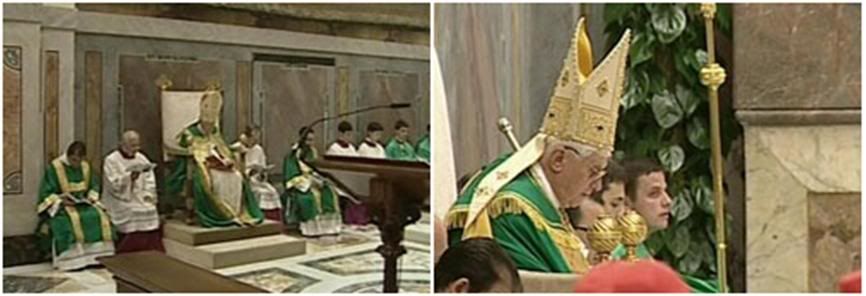
He said in his homily that "the paintings and decorations which adorn the chapel help in meditation ans prayer, especially the two great frescoes by Michelangelo Buonarroti, the last works of his long life".
The two murals represent the conversion of St. Paul and the crucifixion of St. Peter.
The Pope reflected on Michelangelo's depiction of the two saints.
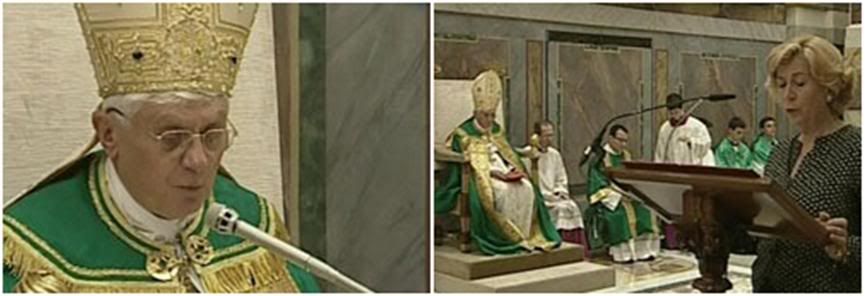

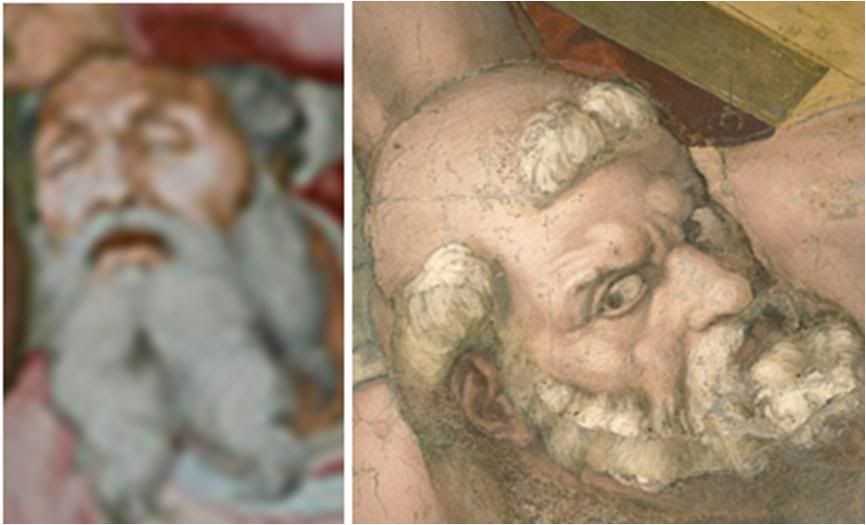
Referring to the St. Paul mural, he said, "Why is he represented so old? It is the face of an old man, and we know - which Michelangelo also did - that Christ's call to Saul on the road to Damascus took place when Saul was about 30."
"The artist's choice take us away from pure realism - it takes us away from pure narration of an event to introduce us to a more profound level. The face of Paul - which is that of the artist himself grown old, disquieted, and in search of the light of truth - represents the human being in need of a superior light".
[In a story yesterday, Vatican art historians identified a blue-turbaned man in the Peter mural as a self-portrait of Michelangelo. See story in the CHURCH&VATICAN thread.]
As for the mural on Peter, the Pope said, "This face, too, surprises us. Particularly in the eyes and in the forehead, the face seems to express the state of mind of man in the face of death and evil: there is a lost look, a sharp outwardly projected look, almost like looking for something or someone at the final moment".
Thus, for the Pope, "the two icons become the two acts of a single drama: the drama of the Paschal mystery, the Cross and Resurrection, death and life, sin and grace".
"For whoever comes to pray here, for the Pope first of all," he concluded, "Peter and Paul become teachers of the faith".

The restoration project began in 2002 under the direction of art historian Arnold Nesselrath. One can say that the Pauline Chapel represents Michelangelo's last artistic effort.
"It is a sort of spiritual testament from the artist", according to Antonio Paolucci, director of the Vatican Museums.
Restoration of the murals brought to light certain details not previously defined like the nails on the cross, and Michelangelo's last brush strokes in the mural on the crucifixion of Peter.
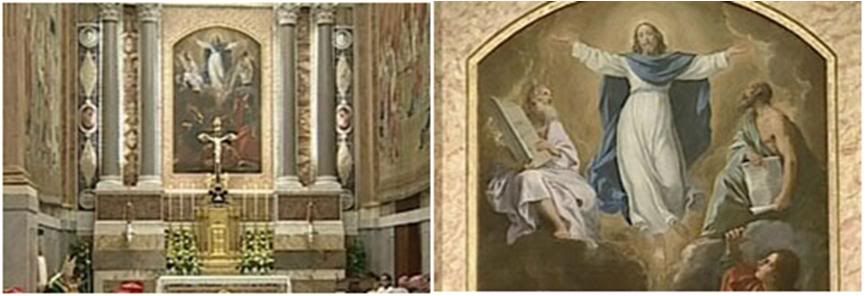
The other major novelty in the restored chapel is that the altar has been reset more or less in its historic location, where it was before Paul VI had it adapted for the Novus Ordo in the late 1960s.
The resetting of the altar was done according to the instructions of Benedict XVI when he visited the worksite last February. However, instead of being brought back up against the wall, enough space was left between it and the wall to allow a priest to celebrate the Mass as in the Novus Ordo, though the precious marble altar is configured once again for the traditional ad-Orientem Mass.
Because it is the Pope's personal chapel, the Pauline Chapel is not part of the itinerary on the Vatican Museums tour. It would be used for morning Mass offered by the Pope when he has guests. Otherwise, he will continue to say morning Mass with his two secretaries and household staff in his private chapel in the papal apartment.
The Pauline chapel was commissioned by Paul III, a Farnese Pope, from Antonio da Sangallo (1537-42). Michelangelo was later asked to execute the two murals on Paul and Peter, which he worked on from 1542-1550.
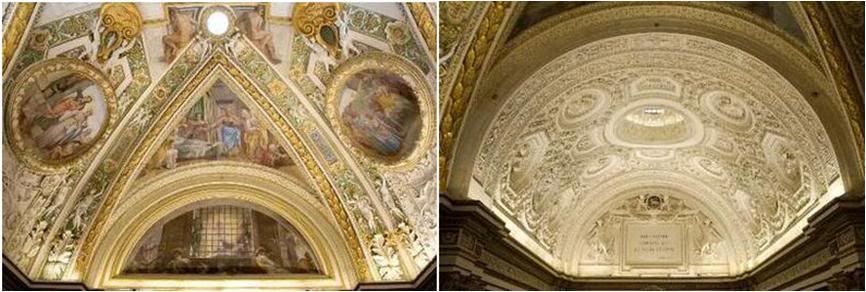
Thanks to Gregor Kollmorgen at
 for the following videocaps which complete the photo sampling of the event
for the following videocaps which complete the photo sampling of the event:
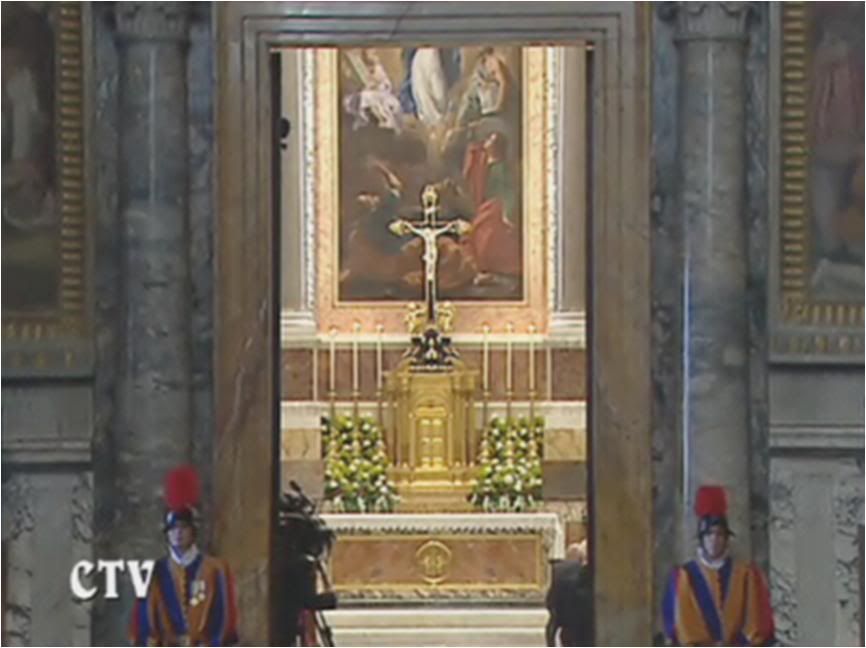
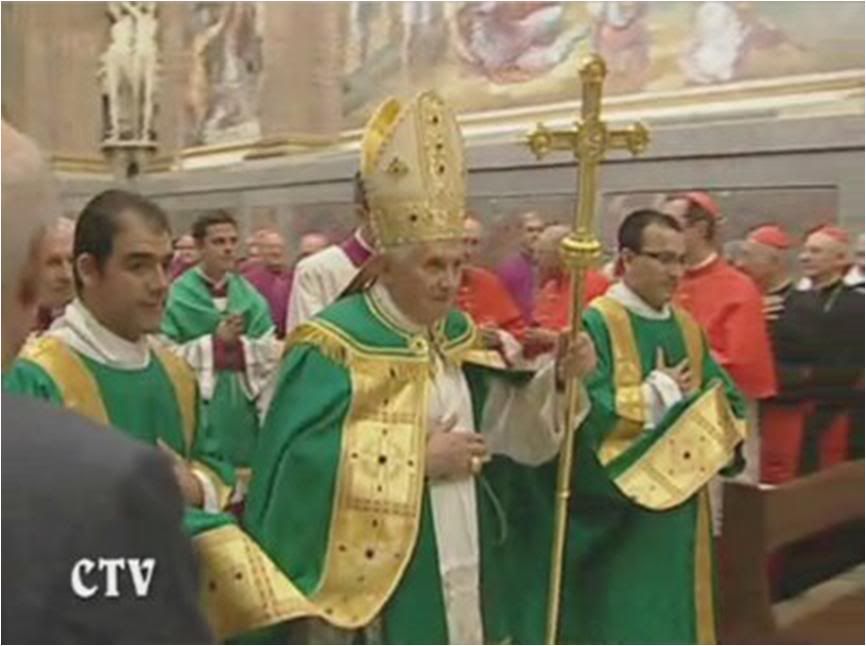 Note the TV monitors built into the front of the chapel and a confessional at the rear:
Note the TV monitors built into the front of the chapel and a confessional at the rear:
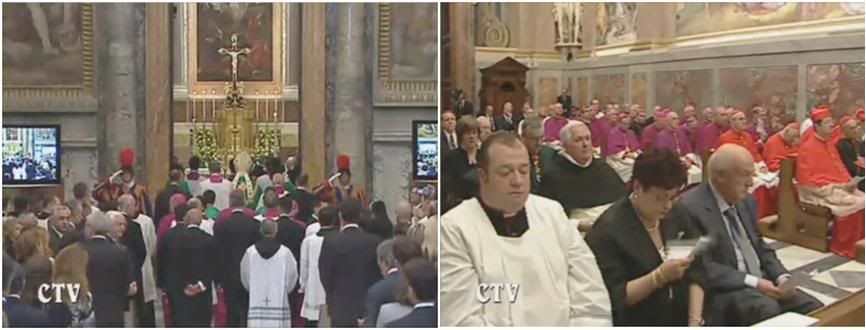
Vespers ended with Adoration of the Blessed Sacrament and Benediction:
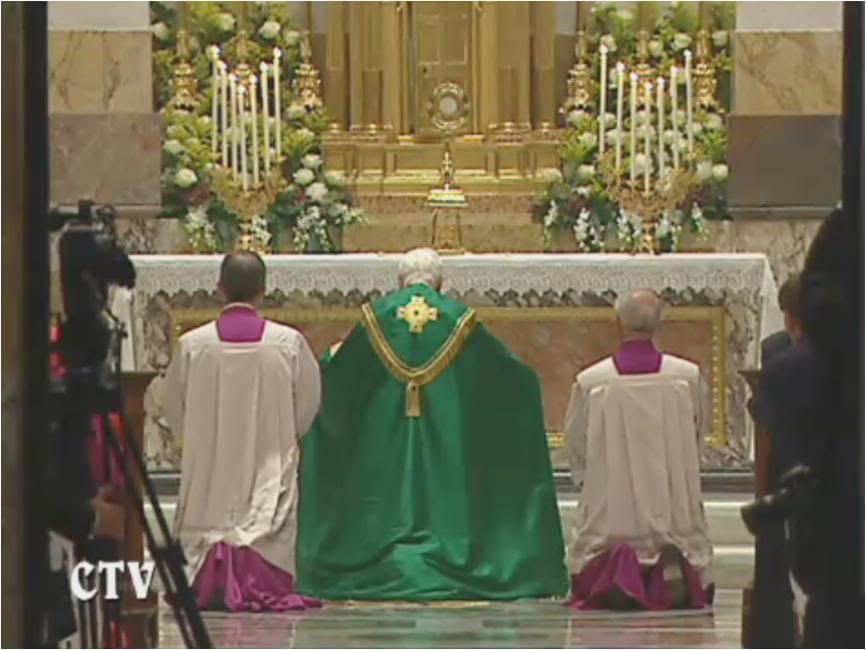

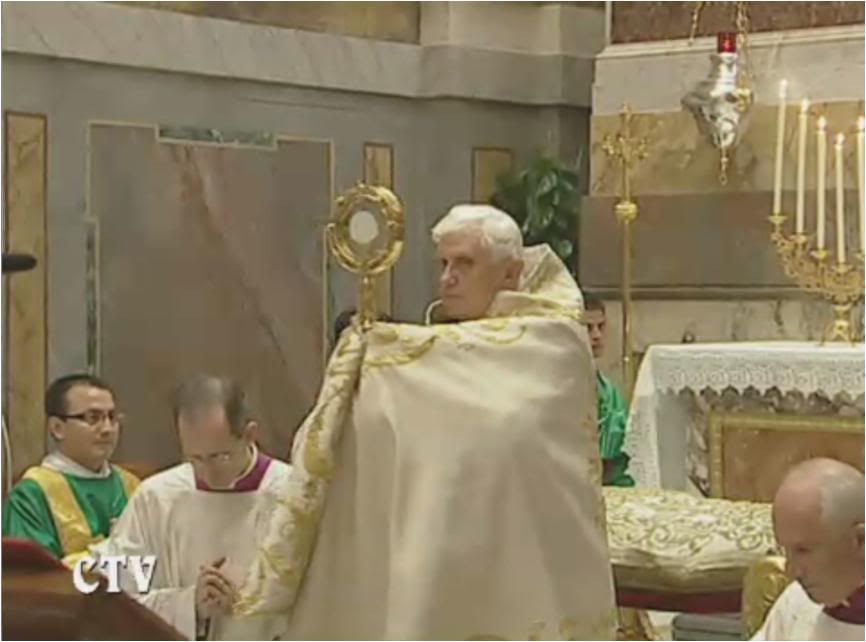 Here is a translation of the Holy Father's homily:
Here is a translation of the Holy Father's homily:
THE HOLY FATHER'S HOMILY
Eminent Cardinals,
Venerated brothers int he episcopate and priesthood,
Dear brothers and sisters:
Today, a few days after the Solemnity of Saints Peter and Paul and the closing of the Pauline Year, my desire to be able to reopen the Pauline Chapel to worship is realized.
We observced the solemn celebrations in honor of the two Apostles in the papal Basilicas of St. Paul and St. Peter. This evening, almost as though in completion, we are gathered in the heart of the Apostolic Palace, in the Chapel thought of by Paul III and executed by Antonio da Sangallo the Younger as a place of prayer for the Pope and for the Pontifical Family.
An aid to even more effective meditation and prayer are the paintings and decorations which adorn it, particularly the two large frescoes by Michelangelo Buonarroti, which are the last works in his long existence. They represent the conversion of St. Paul and the crucifixion of St. Peter.
The eye is attracted first of all to the faces of the two Apostles. It is evident, from their position, that these two faces play a central role in the iconographic message of the Chapel.
Beyond their placement [within the painting], they immediately bring us 'beyond' the image: they interpellate us and lead us to reflect.
First of all, let us dwell of St. Paul. Why is he represented with an aged face? This is the face of an old man, whereas we know - and Michelangelo knew it, as well - that the call to Saul on the road to Damascus occurred when he was about 30 years old.
The choice of the artist already takes us outside pure realism - it makes us go beyond the simple narration of an event to introduce us to a more profound level.
The face of Saul-Paul - which is that of the artist himself who has become old, restless, seeking the light of truth - represents the human being who is in need of a superior light.
It is the light of divine grace, indispensable for acquiring a new vision with which to perceive reality, oriented towards 'the hope reserved for us in heaven' - as the Apostle writes in the initial greeting of his Letter to the Colossians which we just heard (1,5).
The face of Saul fallen to the ground is illuminated from on high, by the light of the Resurrected Lord, and despite its high drama, the depiction inspires peace and instills certainty.
It expresses the maturity of a man interiorly illuminated by Christ the Lord, while surrounded by an agitation in which all the other figures seem to be in a vortex.
The grace and peace of God have wrapped around Saul - he has been conquered and interiorly transformed. That same 'grace' and that same 'peace' are what he would announce to all the communities during his apostolic voyages, with a maturity of age - not literally, but spiritually - given to him by the Lord himself.
Therefore, in the face of Paul, we can already perceive the heart of this Chapel's spiritual message: the wonder of Christ's grace which transforms and renews man through the light of his truth and his love. This is what constitutes the novelty of conversion, of the call to faith, which finds its fulfillment in the mystery of the Cross.
And so, from the face of Paul, we turn to that of Peter, depicted at the moment when his inverted cross is being raised, and he turns to look at whoever is observing him. Even this face is surprising to us.
The age shown here is the right one, but it is the expression which makes us wonder and which interpellates us. Why this expression? It is not a face of pain, and Peter's figure conveys surprising physical vigor.
The face, especially the eyes and the forehead, seems to express the state of mind of a man confronting death and evil. There is a lost look, a sharp outwardly projected look, almost like searching for something or someone at the final moment.
Even in the faces of the persons around him, the eyes stand out. They seem to wander about in agitation, and some look outright frightened or lost. What does all this mean?
It is what Jesus had said earlier to his disciples: "When you were younger, you used to dress yourself and go where you wanted" and the Lord added, "Follow me" (Jn 21,18-19). And here, the culmination of following Christ is taking place: when the disciple is no longer at the side of the Master, he experiences all the bitterness of the Cross, of the consequences of sin which separates man from God, all the absurdity of violence and falsehood.
If one comes to this chapel to meditate, one cannot escape from the radicalness of the question posed by the cross: the cross of Christ, head of the Church, and the cross of Peter, his Vicar on earth.
The two faces, on which our eyes have dwelt, face each other. One might even think that Peter's face is turned towards that of Paul, whom, in his turn, does not see [he was blinded by the light of Christ] but now carries in him the light of the Risen Christ.
It is as though Peter, at the supreme moment of trial, were looking for the light that gave true faith to Paul. And this is how in a sense, the two icons can be considered the two acts of a single play: the drama of the Paschal mystery: Cross and Resurrection, death and life, sin and grace.
The chronological order of the events represented may be reversed but the plan of salvation emerges, the plan that Christ himself realizes in himself by bringing it to fulfillment, as we sang just now in the hymn from Paul's Letter to the Philippians.
For whoever comes to pray in this Chapel, but above all for the Pope, Peter and Paul become teachers of faith. With their witness, they invite us to go deeper, to silently meditate the mystery of the Cross, which accompanies the Church to the end of times; and to accept the light of faith, thanks to which the apostolic community could extend to the very ends of the earth the missionary and evangelizing activity which the Risen Lord had entrusted to them.
Here, no solemn celebrations with the people take place. Here, the Successor of Peter and his co-workers can meditate in silence and adore the living Christ, especially present in the Most Blessed Sacrament of the Eucharist.
The Eucharist is the sacrament in which all the work of Redemption is concentrated. In Jesus as Eucharist, we contemplate the transformation of death to life, of violence to love. Hidden under the veils of bread and wine, we recognize with the eyes of faith the same glory that was manifested to the Apostles after the Resurrection, and which Peter, James and John contemplated in foretaste on Mt. Thabor, when Jesus was transfigured before their eyes: a msyerious event, the Transfiguration, which the great canvas of Simone Cantarini [the portrait above the altar] also reproposes to us in this Chapel with singular power.
Indeed, the whole Chapel - the frescoes by Lorenzo Sabatini and Federico Zuccari, the decorations by many other artists subsequently called here by Pope Greogry XIII - all of this, we can say, flow together here into a single hymn to the triumph of life and grace over death and sin, in a highly evocative symphony of praise and love for Christ the Redeemer.
Dear friends, at the end of this brief meditation, I wish to thank all those who cooperated so that we can once again enjoy this sacred place that has been completely restored: Prof. Antonio Paolucci and his pr4edecessor, Dott. Francesco Buranelli, who, as directors of the Vatican Museums, always felt deeply about this most important restoration; the many specialist workers who, under the artistic direction of Prof. Arnold Nesselrath, worked on the frescoes and the other decorations of the Chapel; and in particular, Master Inspector Maurizio De Luca and his assistant Maria Pustka, who directed the restoration of the murals of Michelangelo, availing of advice from an international commission of famous scholaars.
My gratitude also goes t4o Cardinal Giovanni Lajolo and his co-workers at the Governatorate [of Vatican City State], who devoted special attention to the restoration work.
And of course, my warm and dutiful thanks to the worthy Catholic patrons, Americans and otherwise - the Patrons of the Arts - who have been generously involved in the protection and appreciation of the cultural patrimony in the Vatican, and who made possible the results we are now admiring.
To each and everyone, my most heartfelt appreciation.
Shortly, we will be singing the Magnificat. May the Most Blessed Mary, teacher of prayer and adoration, together with Saints Peter and Paul, obtain abundant graces for all those who are gathered in faith in this Chapel.
Tonight, grateful to God for his wonders, and especially for the death and resurrection of his Son, let us raise our praises to him even for the work whose fulfillment we see today.
"Now to him who is able to accomplish far more than all we ask or imagine, by the power at work within us, to him be glory in the church and in Christ Jesus to all generations, forever and ever. Amen!" (Eph 3,20-21).
Finally, definitive photographs of the restored Michelangelo murals -
how clean and fresh they look!
The Conversion of St. Paul
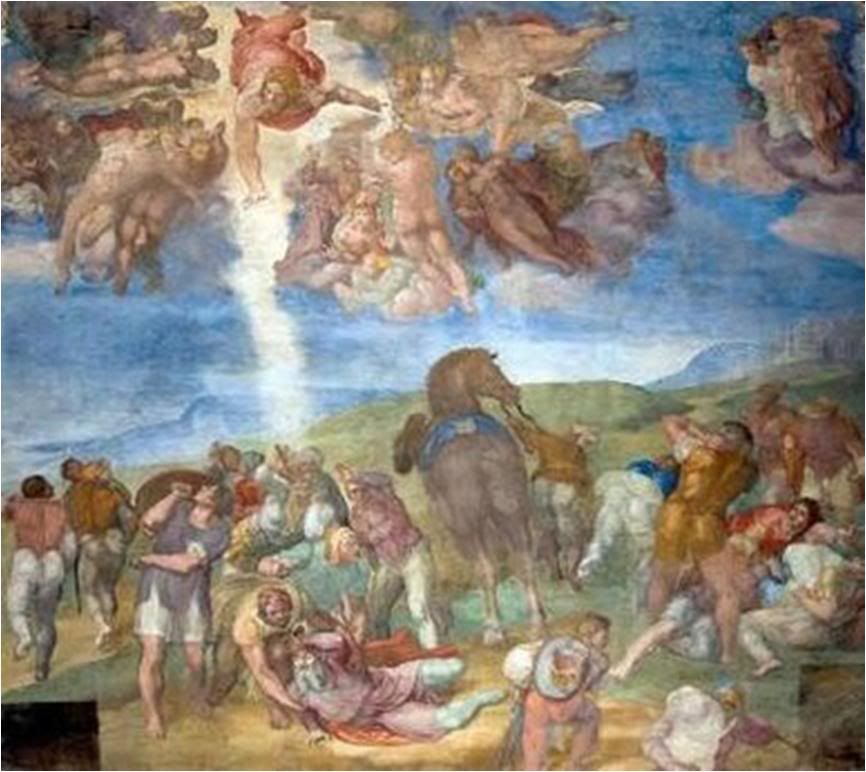 The Crucifixion of St. Peter
The Crucifixion of St. Peter
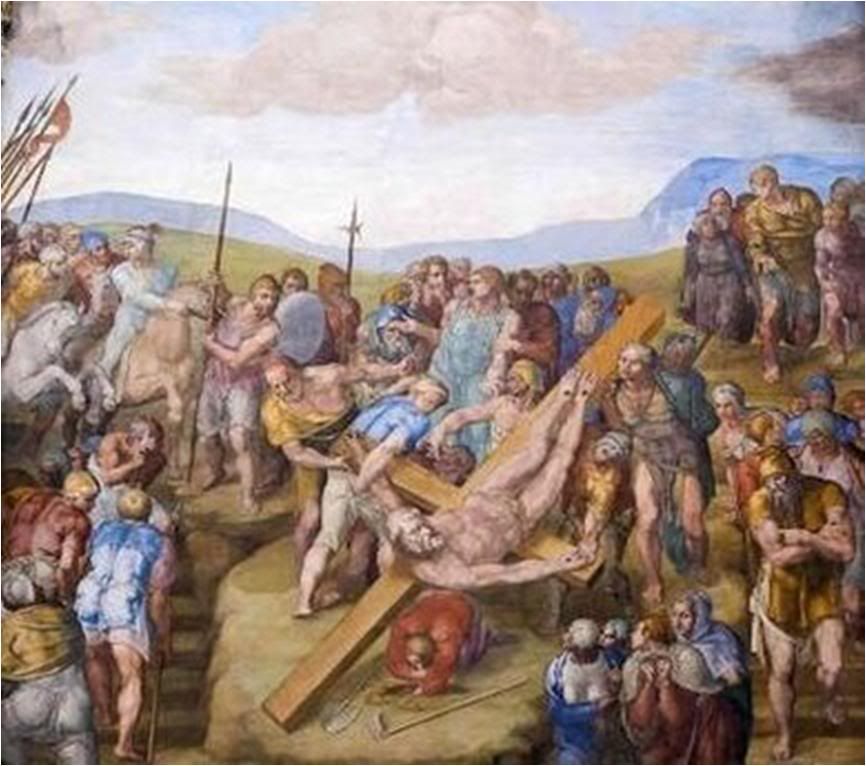
 One must remark on Benedict XVI's truly catholic (in the sense of universal and comprehensive) culture (in the sense of personal knowledge and upbringing) - the very figure of a Renaissance man, who has also all the makings of a saint, as well as Doctor and Father of the Church (as Sandro Magister recently observed)!
One must remark on Benedict XVI's truly catholic (in the sense of universal and comprehensive) culture (in the sense of personal knowledge and upbringing) - the very figure of a Renaissance man, who has also all the makings of a saint, as well as Doctor and Father of the Church (as Sandro Magister recently observed)!
Probably no other leader in the world today can, like him, comment as knowledgeably on diverse matters outside his specific 'competence' (as head of the Catholic Church and as sovereign of Vatican state) as he can on science and technology, art and culture, from his own personal sensibility, i.e., not crafted by speechwriters.
[Sure, he had to consult experts on finance and economy for Caritas in veritate but it was more likely out of prudence rather than real necessity - to make sure he had theory and praxis pinned down precisely, on a subject which seems more arcane than the most complex theology or philosophy, for a document as weighty as an encyclical, committing not just himself personally but the entire Church to a set of teachings.]
Certainly, no other Pope in living memory, has managed to come up with musical and artistic reviews of the kind he has been able to make when the occasion requires. When he was a cardinal, for instance, he even reviewed John Paul II's poetry (a reflection on his predecessor's 'Vatican Triptych').
BENEDICTUS QUI VENIT IN NOMINE DOMINI!
[Modificato da TERESA BENEDETTA 15/07/2009 21:48]